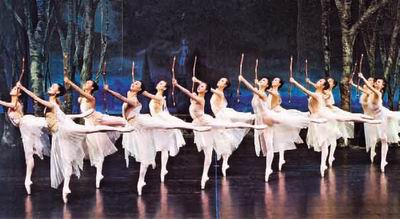
The Beijing-based National Ballet of China will stage
”°Sylvia”± next
week in Shanghai in a joint production with the Opera de
Paris.

French ballet dancers Karl Paquette (left) and Delphine Moussin
attend a press conference yesterday to promote the ballet ”°Sylva," which is
being staged at the Shanghai Grand Theater today and tomorrow.
Shanghai Daily news
When ``French Culture in Shanghai'' was launched as a special session of the
ongoing Shanghai International Arts Festival, organizers vowed to prove to
Chinese audiences that France is more than just a country with some famous
tourist attractions -- like the Eiffel Tower. Their aim was to emphasize the
creative genius of French composers and artists and the glories of its culture.
That ambition has been realized through concerts and art exhibitions which
have opened local eyes to France's cultural achievements. The artistic wave
continues to roll on with a coproduction of the ballet ``Sylvia'' which involves
dancers from the National Ballet of China and the Opera de Paris.
The
National Ballet of China has staged productions in various dance styles in
recent years, including ``Fountain of Tears,'' ``Coppelia'' and ``Rite of
Spring,'' mostly to excellent reviews. But the revival of ``Sylvia'' by the two
companies is likely to be a stand-out success.
The Greco-Roman tale became a
play by Renaissance playwright Torquato Tasso and French operatic composer Leo
Delibes -- whose first major triumph was with ``Coppelia'' -- embraced it as an
opportunity to exercise his talent for writing scores. ``Sylvia'' proved to be
Delibes' best-known ballet -- in fact, it was the most popular ballet music
until Tchaikovsky's ``Swan Lake.''
The score shows a Wagnerian influence and
is full of poetry and sensuality although it does not shrink from some of the
worst cliches of 19th-century ballet music.
Generations of European
choreographers have devoted their lives to shaping dances to go with the
beautiful score and one of the best versions was Sir Frederick Ashton's effort
for Britain's Royal Ballet which was staged in 1952.
In 1979, former prima
ballerina Lycette Darsonval choreographed a version for Opera de Paris and one
year later the same version was staged by the Central Ballet of China (now the
National Ballet of China) in a collaboration between the two companies.
Now,
24 years later, ballet masters Lionel Delanoe, Laurent Novis and Claude de
Vulpian from Opera de Paris are helping to rehearse a production of ``Sylvia''
based on Darsonval's choreography. Even the costumes and sets designed by
Philippe Biont refer back to those of Bernard Dayde's 1979 creations.
But
recreating a classic is by no means easy work.
``I got the tape of the 1979
version a year and a half ago and I have tried to stick to the choreography as
much as I can,'' says Delanoe. ``But it is ridiculous to perform in the way
people danced some 30 years ago since ballet has developed greatly in terms of
technique as well as staging effects. So the hardest thing is to keep the
meaning -- the core of the original version -- and display something fresh and
something that will meet today's tastes.''
The production opens on a
beautifully constructed set of a lush green forest, blooming flowers and
greenery and a prominent statue of Eros, the God of Love. Sylvia discovers the
shepherd Aminta spying on her and she shoots him with her little bow and arrow.
In return, Eros shoots her back and she is smitten with love for the slain
mortal. In her grief, she is kidnapped by the brute Orion and dragged off to his
lair.
Meanwhile, Eros brings Aminta back to life. With Eros' help, Sylvia
escapes from Orion and returns to Aminta but the giant appears again and has a
fight with Aminta. Eros shows up in time and manages to talk chaste Diana into
giving some help and the lovers end up happily.
The role of Sylvia is a
rarity even among other complex ballet stories as she is part Muse, a precocious
coquette and a hunted quarry. Torn between strength and vulnerability, she has
difficulty in finding a balance between aggression and tenderness and only
succeeds in discovering true love with the awakening of her own
sensuality.
The cast for the title role includes Delphine Moussin, prima
ballerina of Opera de Paris, and several Chinese ballerinas who have interpreted
the beautiful Sylvia in different ways.
``I told them the same story in the
same way but did not want to hear them give me the same answer -- and they
didn't,'' Delanoe says. ``They are physically different and are portraying the
character according to their own understanding.''
As to the performance of
the Chinese cast, the French master says he's satisfied.
``I teach them the
same way as I taught in New York. I just share my experience with them. It's not
perfect so far but, you know, there is never perfection.'' Delanoe says.
The
opening performance will feature the Chinese cast while Moussin and Karl
Paquette will star on the second day as part of the festival's closing ceremony.
Date: November 16-17, 7:30pm
Venue: Shanghai Grand Theater, 300 People's
Ave
Tickets: 200-800 yuan
Tel: 6272-0455, 6272-0702



